Auto logout in seconds.
Continue LogoutOverview
To help recruit, retain and support frontline talent, leaders across the industry need to know what clinicians are thinking and how they are making career changes. Read the top 5 takeaways from our clinician survey and to learn how you can better retain and recruit your clinical workforce.
1. Match staff scheduling preferences to business needs.
Clinicians want the agency to select their own schedule according to their preferences. This can look like weekend-only shifts, shorter or longer shifts than standard, and night-only shifts among other variations. Offering clinicians choices may also be beneficial to the organization, as a subset clinicians are likely to want "less-desirable" shifts if those shifts better fit their lifestyles.
2. Offer a flexible menu of benefits to appeal to unique generational needs.
Your organization must offer a comprehensive benefits in order to attract and retain clinicians in different stages of life. While all clinicians value benefits like 401k matching and paid leave, there are some benefits that appeal particularly to younger clinicians, who are looking for financial stability, and older clinicians, who are moving toward retirement. Younger clinicians might value parental leave and tuition reimbursement. Clinicians approaching retirement age might prefer retirement planning assistance and part time work options leading up to retirement.
3. Prioritize hands-on training and career advancement opportunities for early-tenure clinicians.
Offering residency programs and preceptorships will increase clinician skill level and close learning gaps caused by the pandemic. This can also be an opportunity to open the training to all staff, including experienced staff, who want to continue to build their skills.
4. Mitigate clinician burnout to retain clinicians.
Burnout is a universal problem and was widespread even before the pandemic. Covid-19 has worsened burnout as clinicians have had to navigate high patient acuity, staffing shortages, evolving protocols, and even workplace violence all while trying to keep themselves and their families safe from infection. Organizations must focus on supporting staff to mitigate burnout. Reducing administrative burden to lessen workload, reconnecting clinicians to the meaning of their work through storytelling, and involving clinicians in decision-making to give them autonomy are just a few ways your organization can help lessen the impact of burnout.
Methodology
Advisory Board sent the 2022 Clinician Survey to clinical and workforce leaders via email. Leaders distributed it to their frontline staff. Responses were collected from May 2022 to June 2022.
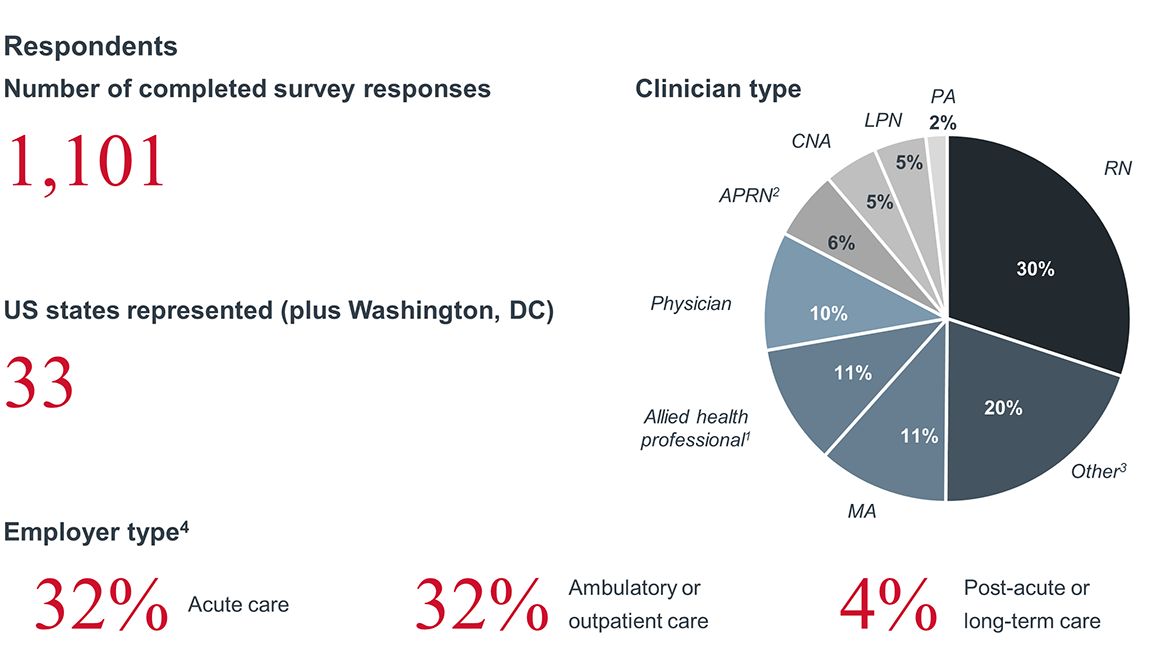
Goals
- Understand what clinicians want and need from their jobs and their employers.
- Learn what drives clinicians’ career decisions.
Key findings
- Despite what many believe, there isn’t a mass exodus of clinicians from health care.
- More than half of clinicians considering leaving their current role plan to remain in a health care job.
- About a quarter of clinicians are considering a role change within the next year, with almost as many unsure of whether they want to stay or leave their current role.
- Job movement and dissatisfaction are concentrated among pockets of the workforce, most notably nursing roles and younger clinicians.
Analysis and implications
- Nurses across the country were stressed, overwhelmed, and burnt out even prior to the pandemic. And pandemic-era dissatisfiers—including inadequate infection control measures, below-license work, compensation volatility, and trauma from Covid care —are now compounded by staffing shortages. As a result of this dissatisfaction, some nurses are moving into new roles.
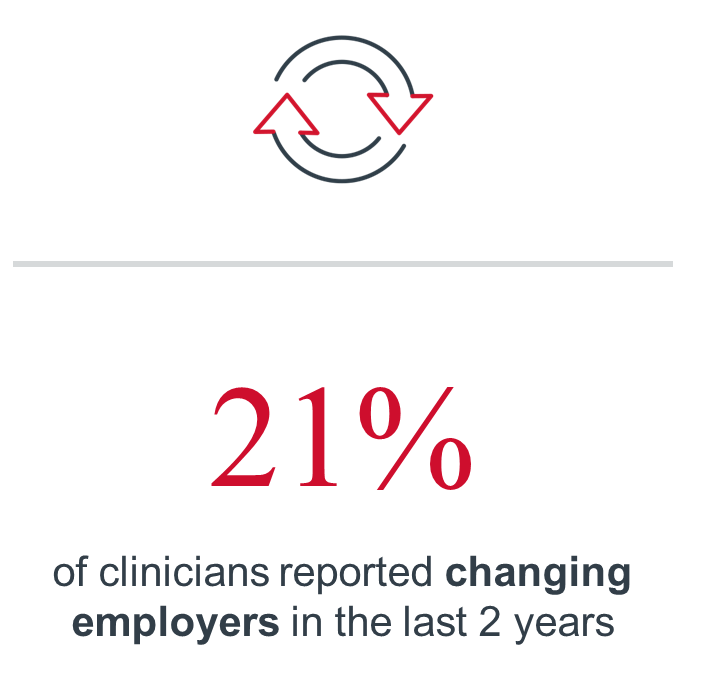
- During the height of the pandemic, early-tenure clinicians faced reduced hands-on training and paused career advancement opportunities. As a result, many clinicians didn’t know what to expect in practice and felt they didn’t have the clinical skills needed to care for patients. This lack of preparation for the challenges of clinical work may have led to early-career dissatisfaction.
- Earlier-tenure clinicians—those ages 18 to 44—are also responding to unique economic incentives, such as inflation and the hot labor market, that weren’t there in recent years. This is causing job movement as younger clinicians seek opportunities with better total rewards or work-life balance.
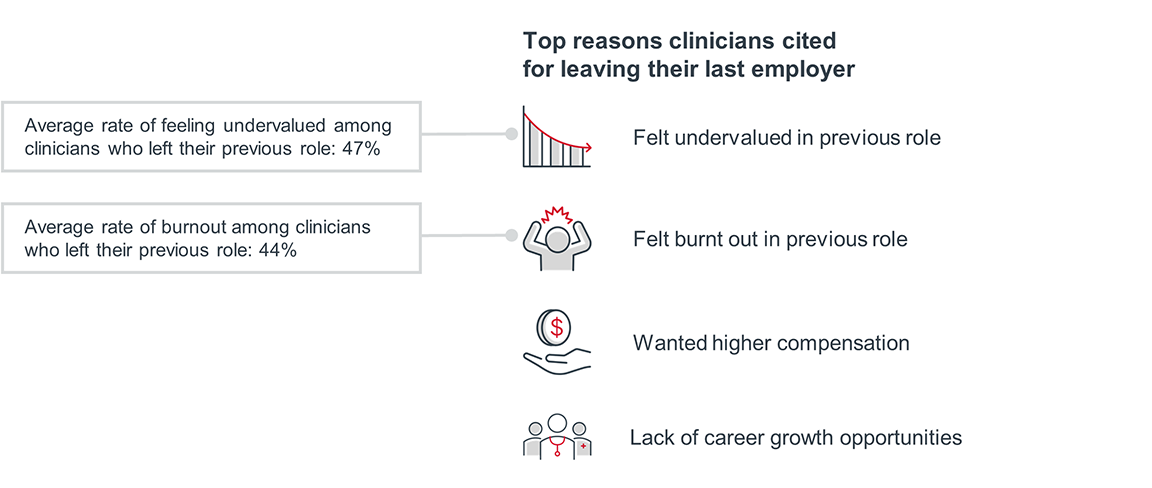
Key findings
- Turnover is driven not by competitive offers, but by how clinicians feel in their current roles.
- Burnout is a universal experience among clinicians.
- “Value” manifests differently across generations, with clinicians ages 55+ reporting feeling undervalued at the highest rates.
Analysis and implications
- The sheer volume of burnout reported across age groups speaks to the fact that all clinicians need additional well-being support from leadership.
- Clinicians ages 55+ may feel particularly undervalued because they perceive a lack of recognition for their expertise or contributions to the organization.
- Distinguishing experienced clinicians, for instance, by offering remote oversight opportunities or training or mentorship roles, can help them feel valued by scaling their knowledge and expertise.
Key findings
- Untenable working conditions—such as mounting burnout and feeling undervalued—prime clinicians to be open to opportunities with better total rewards.
- Clinicians ages 18 to 24 years old and 65+ years old are the most likely to be motivated to leave their current role for one with better compensation.
- Basic benefits are highly attractive for roles where they aren’t always guaranteed.
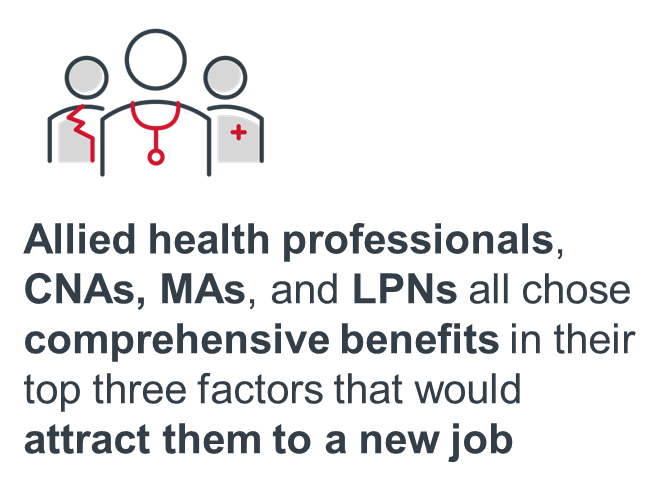

Analysis and implications
- When clinicians perceive a negative work culture, they may leave for higher pay—even if they believe the working conditions will be no better elsewhere.
- Younger generations may be financially driven to pay off student debt if they’re recently out of school, while late-career staff may be close to retirement and trying to maximize their income.
- Leaders should view assistive personnel and lower-paid clinicians as equally important to other roles in patient outcomes and organizational success. Therefore, these clinicians should have access to the same benefits.
Key findings
- Flexibility is the third-most reported factor that would draw clinicians to a new job, coming in after compensation and work-life balance.
- Subsets of mid- to late-career clinicians actually prefer to work harder-to-fill shifts, such as night or weekend schedules.
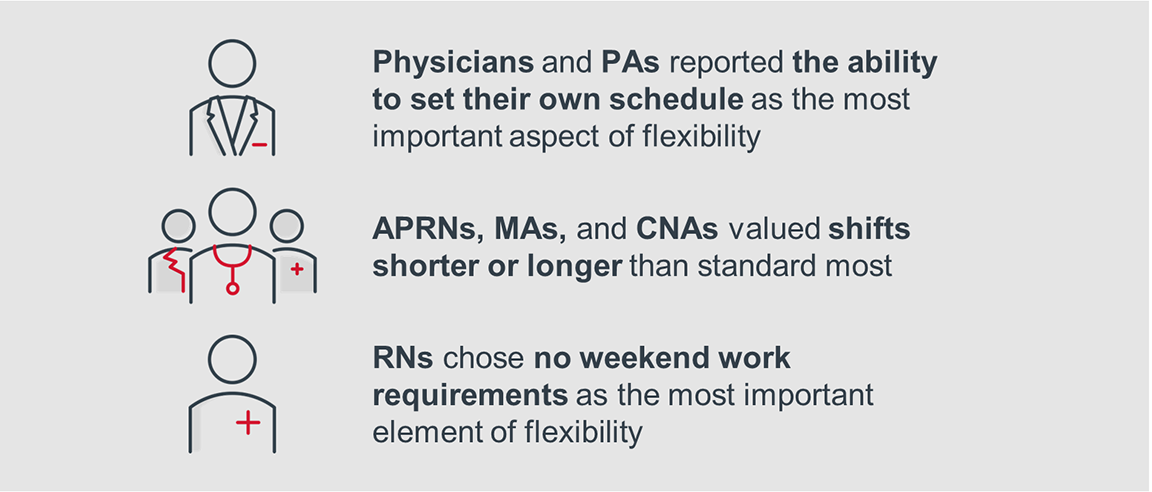
Analysis and implications
- Clinicians value flexibility, but what flexibility looks and feels like can present differently for different people. Flexibility could mean shifts that allow clinicians to pick up their children from school or to attend evening classes.
- People go into health care knowing it’s a hands-on job. Most people aren’t necessarily searching for a 9-5 role or remote work. And while health care operates 24/7, that doesn’t mean you can’t offer any flexibility.
- Employers have an opportunity to match staff preferences to business needs. Whenever possible, leaders should ask staff for their scheduling preferences to improve clinician happiness while meeting organizational needs.
Key findings
Many clinicians considering leaving their roles haven't done so because they are motivated to stay and support their teammates and patients. Connection underpins clinician retention.
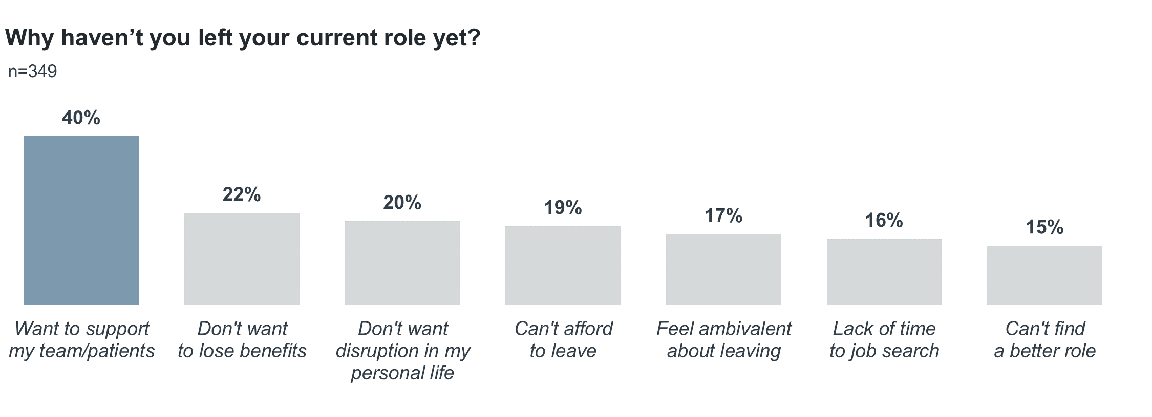
Analysis and implications
- Employees’ conceptions of organizational loyalty has changed. While employer loyalty has waned, clinicians remain loyal to the people they care about.
- Clinicians may feel a sense of responsibility to their teams and perhaps even a duty to continue being there for those who supported them through difficult pandemic-era work. That professional sense of purpose is what connects staff to their roles.
- However, employers can't rely on this form of loyalty to retain staff in the long-term without making major changes to the work culture itself.
- It is the job of leaders to help staff connect with their teams, their patients, and their roles to foster a culture that gives way to meaningful work.
Don't miss out on the latest Advisory Board insights
Create your free account to access 1 resource, including the latest research and webinars.
Want access without creating an account?
You have 1 free members-only resource remaining this month.
1 free members-only resources remaining
1 free members-only resources remaining
You've reached your limit of free insights
Become a member to access all of Advisory Board's resources, events, and experts
Never miss out on the latest innovative health care content tailored to you.
Benefits include:
You've reached your limit of free insights
Become a member to access all of Advisory Board's resources, events, and experts
Never miss out on the latest innovative health care content tailored to you.
Benefits include:
This content is available through your Curated Research partnership with Advisory Board. Click on ‘view this resource’ to read the full piece
Email ask@advisory.com to learn more
Click on ‘Become a Member’ to learn about the benefits of a Full-Access partnership with Advisory Board
Never miss out on the latest innovative health care content tailored to you.
Benefits Include:
This is for members only. Learn more.
Click on ‘Become a Member’ to learn about the benefits of a Full-Access partnership with Advisory Board
Never miss out on the latest innovative health care content tailored to you.

